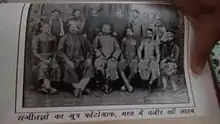Wazir Khan (Rampur)
Wazir Khan served as the head of Arbab-e-Nishat (Music Department of Rampur State) during the period of Nawab Hamid Ali Khan of Rampur.[1] He was also an excellent playwright who established the Rampur theatre in the building of club ghar at Rampur.
Wazir Khan وزير خان | |
|---|---|
 | |
| Born | Wazir Khan 1860 Rampur State |
| Died | 1926 (aged 66) Rampur State |
| Pen name | Wazir(Urdu poetry),Gauhar Piya (Hindi poetry) |
| Occupation | Musician playwright poet musicologist |
| Nationality | Indian |
| Period | 1860–1926 |
| Genre | Hindustani Classical Music Musical Theatre |
| Notable works | Vilayati Chakkar (Urdu Novel) Risala mousibi |
Early life and background
Wazir Khan was born in the erstwhile Rampur State to Ameer Khan Beenkar.[2] Wazir Khan, was the descendant of Naubat Khan and Hussaini (Tansen's daughter).He was an individual whose interests span many fields or areas.Besides being an excellent musician he was a professional playwright.In poetry Wazir Khan was the student of Daagh Dehelvi.He also authored a novel in his lifetime. He was passionate about photography and was also an immaculate Calligrapher.Primarily he used to do Calligraphy in Arabic.Painting was one of his avocation.As a Musicologist he wrote the Risala Mausibi.Wazir Khan was proficient in many languages such as Arabic,Persian,Urdu,Hindi,Bangla,Marathi and Gujarati.[3]
Cuisine
Naubat Khan's family was very fond of food. They were able to develop their own cuisine.Rice preparations were included in their meals and kebab featured regularly. Rakabdars from the court of Awadh were employed in their kitchens. It was said that if anyone from this family is not fond of dessert than he is not a Naubat Khani. These preparations were so rich in ingredients that once Nawab Hamid Ali Khan said that if this family was not fond of such good food they could have houses made of gold and silver.
Disciples
Nayak Wazir Khan was the master of Nawab Hamid Ali Khan of Rampur,[4] Allauddin Khan,[5] Hafiz Ali Khan,[6] Vishnu Narayan Bhatkhande. Alauddin Khan went on to establish the modern Maihar gharana with disciples like Ali Akbar Khan (son), Annapurna Devi (daughter), Pandit Ravi Shankar (son-in-law), Nikhil Banerjee, Vasant Rai, Pannalal Ghosh, Bahadur Khan, and Sharan Rani.

Struggle of Alauddin Khan
Wazir Khan lived like a prince. It was not easy for a commoner to approach the musician directly. Alauddin was quite desperate to become his disciple. It is said that one day he stood in front of the Nawab's vehicle and begged to become Wazir Khan' disciple.[7] The Nawab of Rampur was pleased with his perseverance. The Nawab sent the vehicle to fetch Wazir Khan and Alauddin was made the disciple of Wazir Khan. Wazir Khan taught him nothing for two years, but when he came to know about the hardships Alauddin's wife was facing at home, he started teaching Alauddin.[8]


Family tree
-
 I. Samokhan Singh, Raja of Kishangarh.Imperial Forces fought with the forces of Mughal Emperor Akbar. Samokhan Singh was killed in the battle.
I. Samokhan Singh, Raja of Kishangarh.Imperial Forces fought with the forces of Mughal Emperor Akbar. Samokhan Singh was killed in the battle.
-
 II. Jhanjhan Singh, Yuvraj Sahib of Kishangarh. Present in the battle and was killed.
II. Jhanjhan Singh, Yuvraj Sahib of Kishangarh. Present in the battle and was killed.
-
 III. Misri Singh (Naubat Khan), Yuvraj Sahib of Kishangarh. Put under house arrest. Accepts Islam. Akbar confers title of Khan. First marries Ahmad Khan Mughal's daughter then later Marries Saraswati daughter of Tansen. Jahangir confers the title of Naubat Khan and promotes him to the rank of 500 personal and 200 horse.
III. Misri Singh (Naubat Khan), Yuvraj Sahib of Kishangarh. Put under house arrest. Accepts Islam. Akbar confers title of Khan. First marries Ahmad Khan Mughal's daughter then later Marries Saraswati daughter of Tansen. Jahangir confers the title of Naubat Khan and promotes him to the rank of 500 personal and 200 horse.
- IV. Lal Khan Gunsamundra.Title of Gunsamundra conferred by Shahjahan on 19 November 1637.
- V.Bisram Khan.One of the Chief musicians at the court of Mughal Emperor Shahjahan and Mughal Emperor Aurangzeb
- VI.Manrang
- VII.Bhupat khan
- IX.Sidhar Khan
- VIII. khushal Khan Gunsamundra.
- X. Nirmol Shah
- XI.Naimat Khan, Sadarang.(1670–1748). Developed Khayal,Chief musician of Mohammad Shah Rangeela
- XII. Naubat Khan II
- XIII.Feroz Khan, Adarang.
- XIV.Mohammad Ali Khan
- XV. Omrao Khan.
- XVI. Haji Mohammad Ameer Khan Khandara. Went to perform haj with Nawab Kalb Ali Khan
- XVII. Wazir Khan (Rampur). (1860–1926).Chief musician at the court of Nawab Hamid Ali Khan of Rampur
- XIX. Mohammad Nazeer Khan
- XXII. Mohammad Dabir Khan.
- XXIII.Mohammad Shabbir Khan
- XXII. Mohammad Dabir Khan.
- XX. Mohammad Naseer Khan.
- XXI.Mohammad Sagheer Khan.
- XIX. Mohammad Nazeer Khan
- XVIII. Fida Ali Khan.
- XXIV. Mumtaz Ali Khan.
- XXV. Imtiyaz ali khan.
- XXVI.Imdad Ali Khan.
- XVII. Wazir Khan (Rampur). (1860–1926).Chief musician at the court of Nawab Hamid Ali Khan of Rampur
- XVI. Haji Mohammad Ameer Khan Khandara. Went to perform haj with Nawab Kalb Ali Khan
- X. Nirmol Shah
- IV. Lal Khan Gunsamundra.Title of Gunsamundra conferred by Shahjahan on 19 November 1637.
-
-
References
- Mukhopādhyāẏa, Kumāraprasāda (2006). The Lost World of Hindustani Music. google.co.in. ISBN 9780143061991. Retrieved 31 January 2015.
- Miner, Allyn (April 2004). Sitar and Sarod in the 18th and 19th Centuries. google.co.in. ISBN 9788120814936. Retrieved 31 January 2015.
- Wazir Khan and his prominent disciples a research by Rati Rastogi,RohilKhand University
- Rampur ki Sadarang Parampara by Saryu Kalekar,1984 New Delhi Publications
- Lavezzoli, Peter (24 April 2006). The Dawn of Indian Music in the West. google.co.in. ISBN 9780826418159. Retrieved 31 January 2015.
- Neuman, Daniel M. (15 March 1990). The Life of Music in North India. google.co.in. ISBN 9780226575162. Retrieved 31 January 2015.
- Mehta, Ved (15 December 2013). Portrait of India. Penguin Books. p. 75. ISBN 9789351182771. Retrieved 24 July 2017 – via Google Books.
- Nettl, Bruno; Arnold, Alison; Stone, Ruth M.; Porter, James; Rice, Timothy; Olsen, Dale Alan; Miller, Terry E.; Kaeppler, Adrienne Lois; Sheehy, Daniel Edward; Koskoff, Ellen; Williams, Sean; Love, Jacob Wainwright; Goertzen, Chris; Danielson, Virginia; Marcus, Scott Lloyd; Reynolds, Dwight; Provine, Robert C.; Tokumaru, Yoshihiko; Witzleben, John Lawrence (1998). The Garland Encyclopedia of World Music: South Asia : the Indian subcontinent. google.co.in. ISBN 9780824049461. Retrieved 31 January 2015.
- Wazir Khan and his prominent disciples,a research by Rati Rastogi,RohilKhand University.
- Islamic Culture Journal by Prof. Abdul Haleem, October 1945, P.P 357-386
- Moorthy, Vijaya (2001). Romance of the Raga. google.co.in. ISBN 9788170173823. Retrieved 31 January 2015.